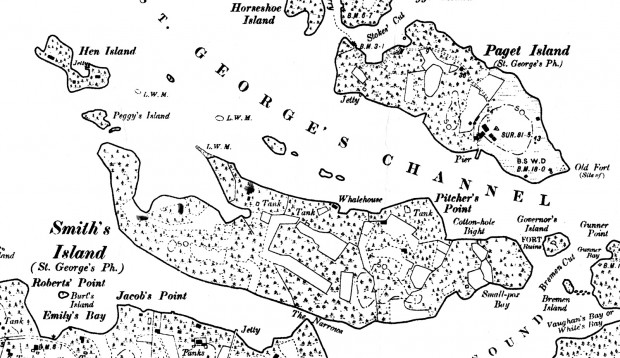Archaeological Team Returns To Smith’s Island
 A team of visiting archaeologists from New York’s University of Rochester returns to Smith’s Island this summer hoping to uncover artifacts associated with Bermuda’s first three permanent residents as well as enslaved 17th century Native Americans and Africans.
A team of visiting archaeologists from New York’s University of Rochester returns to Smith’s Island this summer hoping to uncover artifacts associated with Bermuda’s first three permanent residents as well as enslaved 17th century Native Americans and Africans.
Headed by Dr. Michael Jarvis and working on Smith’s Island since 2010, the team believes they may have identified the precise location where the “Three Kings of Bermuda” — Christopher Carter, Edward Waters and Edward Chard — lived between 1610 and 1612.
The 61 acre island is located near the northern entrance to St. George’s Harbour and has long been known to have been the site of Bermuda’s first permanent settlement, with Carter, Waters and Chard building rough cabins there.
Members of the “Sea Venture” party wrecked in Bermuda, the three men elected to stay behind in Bermuda in 1610 after the Bermuda-built ships “Patience” and “Deliverance” carried the castaways to the English settlement at Jamestown in Virginia.
After some 20 months, the reign of the “Three Kings” came to an end with the arrival of the “Plough” in July, 1612 carrying Richard Moore — Bermuda’s first Governor — and a party of 60 settlers.
Dr. Jarvis, who arrived in Bermuda this week [May 22] for the 2013 Smith’s Island excavations said thanks to a call for volunteers by the Bermuda National Trust, the University of Rochester team will have at least 15 locals digging alongside them this year “ranging from retired couples to teenagers who have been volunteered by their mothers …”
“I really am looking forward to helping Bermudians learn about and unearth their own past,” Dr. Jarvis posted on his blog. “An important but often overlooked part of historical archaeology is engaging and involving the public to promote awareness of the fragility of our cultural heritage and to diversify the range of people included in histories beyond white property-owning men who make up the bulk of those documented in surviving records.
Ordnance survey map of Smith’s Island prepared in 1898/1899 by British Lt. A. J. Savage

“With luck, we will find evidence of enslaved Native Americans, black Bermudian slaves who seasonally worked in the whale house, the three poor English sailors who became the First Bermudians, and the unknown individuals who were forced to stay at the island’s quarantine station and those who nursed them in their illness. I can’t wait to get started!”
Dr. Jarvis has said historians are fortunate that the “prudent preservation efforts” of the Bermuda National Trust and Government’s National Parks system have saved Smith’s Island from development.
Dr. Jarvis is the author of the award-winning “In The Eye Of All Trade” – the first ever social and cultural account of 18th century Bermuda and the first book to explore the unique ties between black and white Bermudian mariners whose seafaring exploits aboard the island’s cedar sloops opened a new chapter in Atlantic maritime history.
The historical research project is focused on exploring four centuries of Bermudian history through targeted excavations.
This research has been made possible with support from the University of Rochester, the Bermuda National Trust, the St. George’s Foundation, the Spurling family, Norman and Anne Brown, Geoffrey Redmond, and members of the Bermuda National Trust’s Archaeological Research Committee.
Read More About
Category: All, Environment, History


I would love to join. How can I?
I am a (semi)retired archeologist from Schoharie, NY, with 40 years of professional experience. I worked for the NYSOPRHP (Bureau of Historic Sites) for 15 years, a private firm in Wyoming (Independent Archeological Consultants) for 5 years, and for the last 20 years with Hartgen Archeological Associates, in Albany.
I have had the opportunity to discover and excavate several 17th century sites–European, Native American, and mixed ethnic sites– in and around Albany NY. I believe I could make a substantial contribution to your on-going project.
Please contact me asap, if you are interested in my services, this year or the coming years. I look forward to hearing from you.